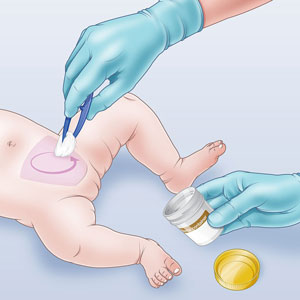Background
- UTI cannot be diagnosed on symptoms alone
- Growth is required to confirm (dipstick has inadequate sensitivity/specificity)
- If child is unwell, finding a UTI does not exclude another septic focus (e.g. meningitis) (2% of children have asymptomatic bacturia)
- Dipstick test is for screening only:
- Blood & protein are unreliable markers of UTI
- Some bacteria do not produce nitrates
- Infants may not have pyuria even with confirmed UTI
- Leukocytes may appear in urine with many other (e.g. meningitis/AOM) infections
Clinical
- In infants, features are often non-specific (e.g. irritability, vomiting, poor feeding)
- Older children may report loin or abdominal pain, frequency and dysuria
- Full "septic" clinical examination (ENT, neurological, respiratory abdominal exam etc.)
- Remember to continue to search for clinical pneumonia / meningitis etc even if bacturia is found

Investigations
- Never use a urine bag
- MSU if child old enough
- In infants, use the Quick-Wee method in preference to clean catch
- Suprapubic aspirate if cannot wait (unwell++) for clean catch
- Catheter specimen only after fail SPA
- FBC, cultures, U&E, CRP if clinically unwell
Management
- If unwell or all < 6/12 = admit paediatrics (IV antibiotics)
- IV fluids
- LP if clinical meningitis
- Usually start with IV gentamicin and penicillin (check with paediatrics)
- PO trimethoprim or cephalexin if older child and clinically well AFTER MSU sent for culture
- Admit paediatrics if <6/12, unwell, renal or medical history, recurrent UTI
Follow up (GP)
Renal US
- Unwell, slow to respond or those <3/12
- <6/12 US within 1 month
- Older children with mild UTI do not need US on first UTI but will require renal imaging on second / recurrent UTI
Paediatric OPD
- All children with proven UTI
Links
Quick Wee methos - BMJ 2017 (http://www.bmj.com/content/357/bmj.j1341).